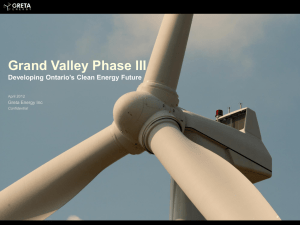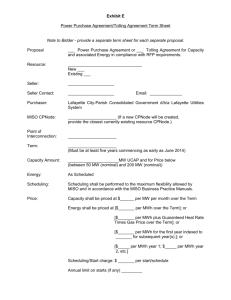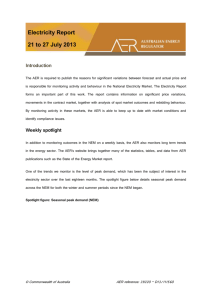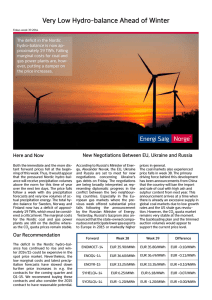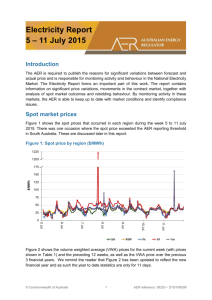Electricity Report 28 June - 4 July 2015
advertisement
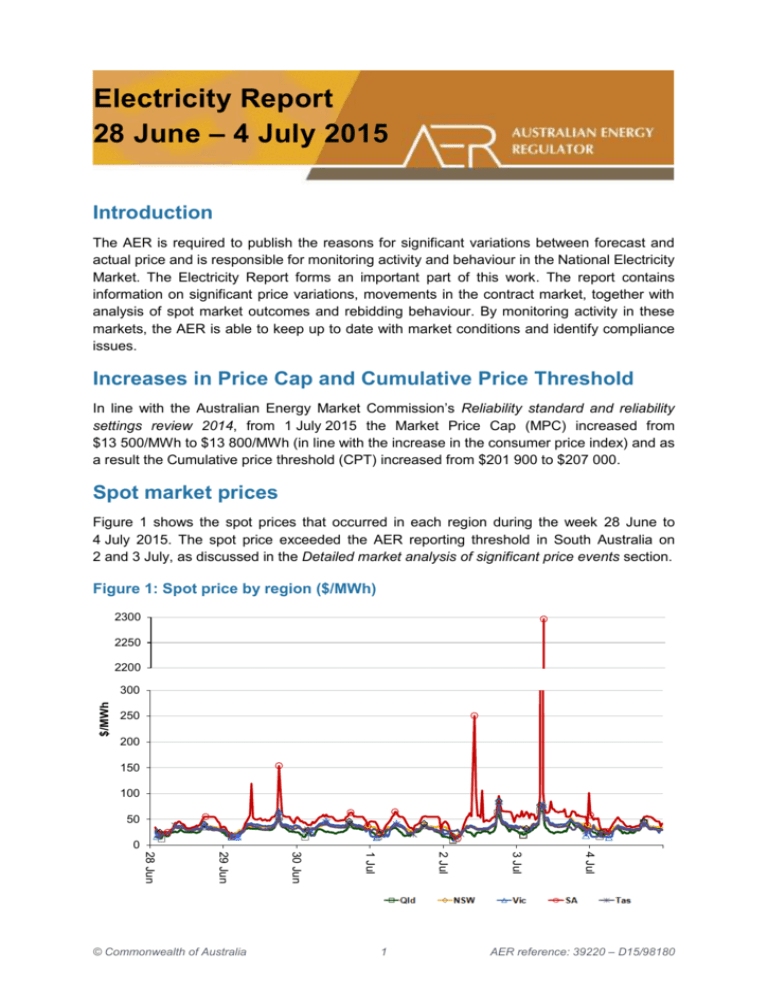
Electricity Report 28 June – 4 July 2015 Introduction The AER is required to publish the reasons for significant variations between forecast and actual price and is responsible for monitoring activity and behaviour in the National Electricity Market. The Electricity Report forms an important part of this work. The report contains information on significant price variations, movements in the contract market, together with analysis of spot market outcomes and rebidding behaviour. By monitoring activity in these markets, the AER is able to keep up to date with market conditions and identify compliance issues. Increases in Price Cap and Cumulative Price Threshold In line with the Australian Energy Market Commission’s Reliability standard and reliability settings review 2014, from 1 July 2015 the Market Price Cap (MPC) increased from $13 500/MWh to $13 800/MWh (in line with the increase in the consumer price index) and as a result the Cumulative price threshold (CPT) increased from $201 900 to $207 000. Spot market prices Figure 1 shows the spot prices that occurred in each region during the week 28 June to 4 July 2015. The spot price exceeded the AER reporting threshold in South Australia on 2 and 3 July, as discussed in the Detailed market analysis of significant price events section. Figure 1: Spot price by region ($/MWh) 2300 2250 2200 $/MWh 300 250 200 150 100 50 0 4 Jul 1 3 Jul 2 Jul 1 Jul 30 Jun 29 Jun 28 Jun © Commonwealth of Australia AER reference: 39220 – D15/98180 Figure 2 shows the volume weighted average (VWA) prices for the current week (with prices shown in Table 1) and the preceding 12 weeks, as well as the VWA price over the previous 3 financial years. Figure 2: Volume weighted average spot price by region ($/MWh) 120 100 $/MWh 80 60 40 20 0 Current week Previous week Tas 14 Jun 7 Jun SA 31 May Vic 24 May 17 May NSW 10 May 3 May 26 Apr 19 Apr 12 Apr 5 Apr 13/14 FY 12/13 FY 11/12 FY Qld Table 1: Volume weighted average spot prices by region ($/MWh) Region Qld NSW Vic SA Tas Current week 28 36 35 59 33 13-14 financial YTD 60 53 54 68 42 14-15 financial YTD 61 36 32 43 37 Longer-term statistics tracking average spot market prices are available on the AER website. Spot market price forecast variations The AER is required under the National Electricity Rules to determine whether there is a significant variation between the forecast spot price published by the Australian Energy Market Operator (AEMO) and the actual spot price and, if there is a variation, state why the AER considers the significant price variation occurred. It is not unusual for there to be significant variations as demand forecasts vary and participants react to changing market conditions. A key focus is whether the actual price differs significantly from the forecast price either four or 12 hours ahead. These timeframes have been chosen as indicative of the time frames within which different technology types may be able to commit (intermediate plant within four hours and slow start plant within 12 hours). There were 77 trading intervals throughout the week where actual prices varied significantly from forecasts. This compares to the weekly average in 2014 of 71 counts and the average in 2013 of 97. Reasons for the variations for this week are summarised in Table 2. Based on AER analysis, the table summarises (as a percentage) the number of times when the actual price differs significantly from the forecast price four or 12 hours ahead and the major reason for that variation. The reasons are classified as availability (which means that there is a 2 change in the total quantity or price offered for generation), demand forecast inaccuracy, changes to network capability or as a combination of factors (when there is not one dominant reason). An instance where both four and 12 hour ahead forecasts differ significantly from the actual price will be counted as two variations. Table 2: Reasons for variations between forecast and actual prices Availability Demand Network Combination % of total above forecast 7 54 0 2 % of total below forecast 23 13 0 1 Note: Due to rounding, the total may not be 100 per cent. Generation and bidding patterns The AER reviews generator bidding as part of its market monitoring to better understand the drivers behind price variations. Figure 3 to Figure 7 show, the total generation dispatched and the amounts of capacity offered within certain price bands for each 30 minute trading interval in each region. Figure 3: Queensland generation and bidding patterns 12000 10000 MW 8000 6000 4000 2000 0 12 noon - 4 Jul 3 12 noon - 3 Jul $0/MWh to $50/MWh $500/MWh to $5000/MWh 12 noon - 2 Jul 12 noon - 1 Jul 12 noon - 30 Jun 12 noon - 29 Jun 12 noon - 28 Jun <$0/MWh $100/MWh to $500/MWh Total generation (MW) $50/MWh to $100/MWh Above $5000/MWh Figure 4: New South Wales generation and bidding patterns 16000 14000 12000 MW 10000 8000 6000 4000 2000 0 12 noon - 4 Jul 12 noon - 3 Jul 12 noon - 2 Jul 12 noon - 1 Jul 12 noon - 30 Jun 12 noon - 29 Jun 12 noon - 28 Jun <$0/MWh $100/MWh to $500/MWh Total generation (MW) $50/MWh to $100/MWh Above $5000/MWh $0/MWh to $50/MWh $500/MWh to $5000/MWh Figure 5: Victoria generation and bidding patterns 12000 10000 MW 8000 6000 4000 2000 0 $50/MWh to $100/MWh Above $5000/MWh 12 noon - 4 Jul 4 12 noon - 3 Jul $0/MWh to $50/MWh $500/MWh to $5000/MWh 12 noon - 2 Jul 12 noon - 1 Jul 12 noon - 30 Jun 12 noon - 29 Jun 12 noon - 28 Jun <$0/MWh $100/MWh to $500/MWh Total generation (MW) Figure 6: South Australia generation and bidding patterns 3500 3000 2500 MW 2000 1500 1000 500 0 12 noon - 4 Jul 12 noon - 3 Jul 12 noon - 2 Jul 12 noon - 1 Jul 12 noon - 30 Jun 12 noon - 29 Jun 12 noon - 28 Jun <$0/MWh $100/MWh to $500/MWh Total generation (MW) $50/MWh to $100/MWh Above $5000/MWh $0/MWh to $50/MWh $500/MWh to $5000/MWh Figure 7: Tasmania generation and bidding patterns 2500 2000 MW 1500 1000 500 0 12 noon - 4 Jul 5 12 noon - 3 Jul $0/MWh to $50/MWh $500/MWh to $5000/MWh 12 noon - 2 Jul 12 noon - 1 Jul 12 noon - 30 Jun 12 noon - 29 Jun 12 noon - 28 Jun <$0/MWh $100/MWh to $500/MWh Total generation (MW) $50/MWh to $100/MWh Above $5000/MWh Frequency control ancillary services markets Frequency control ancillary services (FCAS) are required to maintain the frequency of the power system within the frequency operating standards. Raise and lower regulation services are used to address small fluctuations in frequency, while raise and lower contingency services are used to address larger frequency deviations. There are six contingency services: fast services, which arrest a frequency deviation within the first 6 seconds of a contingent event (raise and lower 6 second) slow services, which stabilise frequency deviations within 60 seconds of the event (raise and lower 60 second) delayed services, which return the frequency to the normal operating band within 5 minutes (raise and lower 5 minute) at which time the five minute dispatch process will take effect. The Electricity Rules stipulate that generators pay for raise contingency services and customers pay for lower contingency services. Regulation services are paid for on a “causer pays” basis determined every four weeks by AEMO. The total cost of FCAS on the mainland for the week was $300 000 or less than 1 per cent of energy turnover on the mainland. The total cost of FCAS in Tasmania for the week was $122 500 or around 2 per cent of energy turnover in Tasmania. Figure 8 shows the daily breakdown of cost for each FCAS for the NEM, as well as the average cost since the beginning of the previous financial year. Figure 8: Daily frequency control ancillary service cost 120 000 100 000 80 000 $ 60 000 40 000 20 000 0 Raise Reg Lower Reg 4 Jul Raise 5min Lower 5min 3 Jul 6 2 Jul Raise 60sec Lower 60sec 1 Jul 30 Jun 29 Jun 28 Jun Average cost Raise 6sec Lower 6sec Detailed market analysis of significant price events We provide more detailed analysis of events where the spot price was greater than three times the weekly average price in a region and above $250/MWh or was below -$100/MWh. South Australia There were two occasions where the spot price in South Australia was greater than three times the South Australia weekly average price of $59/MWh and above $250/MWh. Thursday, 2 July Table 3: Price, Demand and Availability Time Price ($/MWh) Actual 10.30 am 250.82 Demand (MW) Availability (MW) 4 hr forecast 12 hr forecast Actual 4 hr forecast 12 hr forecast Actual 4 hr forecast 12 hr forecast 54.99 54.99 1640 1635 1655 2222 2349 2280 Four hours ahead, demand and Interconnector flows were close to forecast, while available capacity was over 100 MW lower than forecast. Table 4: Rebids for the 10.30 am trading interval Submit time Time effective Participant Station Capacity rebid (MW) Price from ($/MWh) Price to ($/MWh) Rebid reason 0905~P~020 reduction in avail cap~201 gas conservation-SL 0930A avoid uneconomic start SL 9.18 am AGL Torrens Island 9.32 am Origin Ladbroke 158 <200 N/A 9.54 am Alinta Northern 30 46 13 334 0945~A~Hallet started~ -1000 10:03 A adj bands due to mat change in SA 5MPD price SL 361 10:09 a bands adj mat chng SA 5mpd price 350.99 vs 45.99 @1015 10.03 am 10.10 am 10.10 am 10.20 am EA EA Hallett 330 <65 351 15 Hallett 35 >361 -1000 The above rebids reduced the amount of low-priced capacity available during this period creating a steep supply curve in South Australia. The Heywood interconnector was limited to around 280 MW four hours ahead, as forecast. Ramping constraints were invoked from 10 am to manage the planned outage of the Murraylink interconnector from 10.35 am. The ramping constraints caused the import limit into South Australia across Murraylink to reduce from 160 MW at 9.55 am to zero by 10.15 am, remaining there for the rest of the trading interval. The reduction in imports and low price capacity (through rebidding) caused the dispatch price to reach $350/MWh at 10.05 am. However, rebidding to the price floor by Energy 7 Australia at Hallett caused the dispatch price to fall to below $55/MWh for the 10.10 am and 10.15 am dispatch intervals, before increasing again to $350/MWh from 10.20 am to the end of the trading interval when Energy Australia rebid capacity from the price floor to above $360/MWh. Friday, 3 July Table 5: Price, Demand and Availability Time 8.30 am Price ($/MWh) Demand (MW) Availability (MW) Actual 4 hr forecast 12 hr forecast Actual 4 hr forecast 12 hr forecast Actual 4 hr forecast 12 hr forecast 2296.32 66.69 64.94 1884 1923 1898 2199 2214 2273 Conditions at the time saw demand and available capacity close to that forecast. There was only 48 MW of wind generation in South Australia at the time. At 7.58 am, effective from 8.05 am, Alinta Energy rebid 223 MW of available capacity at Northern Power Station from prices below $55/MWh to $13 334/MWh. The reason given was “0755~A~DISPATCH $142 V 5PD $93.06~”. This rebid resulted in a steep supply curve in South Australia (little capacity priced between $55/MWh and $12 000/MWh), meaning small changes in demand, rebids or interconnector flows could lead to large changes in price. The dispatch price increased from $154/MWh at 8.05 am to $13 334/MWh at 8.10 am following a slight increase in demand and a reduction in wind powered generation. The price was set by Northern Power station. Alinta Energy subsequently reversed the rebid at Northern Power Station which resulted in the dispatch price returning to previous levels from 8.15 am for the remainder of the trading interval. Financial markets Figure 9 shows for all mainland regions the prices for base contracts (and total traded quantities for the week) for each quarter for the next four financial years. 8 120 900 100 750 80 600 60 450 40 300 20 150 0 Number of contracts traded $/MWh Figure 9: Quarterly base future prices Q3 2015 – Q2 2019 0 Q2 2019 Q1 2019 Vic volume Vic Q4 2018 Q3 2018 Q2 2018 Q1 2018 NSW volume NSW Q4 2017 Q3 2017 Q2 2017 Q1 2017 Q4 2016 Q3 2016 Q2 2016 Q1 2016 Q4 2015 Q3 2015 Qld volume Qld SA volume SA Source: ASXEnergy.com.au Figure 10 shows how the price for each regional Quarter 1 2016 base contract has changed over the last 10 weeks (as well as the total number of trades each week). The closing quarter 1 2014 and quarter 1 2015 prices are also shown. The AER notes that data for South Australia is less reliable due to very low numbers of trades. 100 750 80 600 60 450 40 300 20 150 0 Number of contracts traded $/MWh Figure 10: Price of Q1 2016 base contracts over the past 10 weeks (and the past 2 years) 0 Current 21 Jun Vic volume Vic 14 Jun 07 Jun NSW volume NSW 31 May 24 May 17 May 10 May 03 May 26 Apr Q1 2015 Q1 2014 Qld volume Qld SA volume SA Note: Base contract prices are shown for each of the current week and the previous 9 weeks, with average prices shown for yearly periods 1 and 2 years prior to the current year. Source: ASXEnergy.com.au Prices of other financial products (including longer-term price trends) are available in the Performance of the Energy Sector section of our website. Figure 11 shows how the price for each regional Quarter 1 2016 cap contract has changed over the last 10 weeks (as well as the total number of trades each week). The closing quarter 1 2014 and quarter 1 2015 prices are also shown. 9 Figure 11: Price of Q1 2016 cap contracts over the past 10 weeks (and the past 2 years) 50 250 40 200 35 $/MWh 30 150 25 20 100 15 10 50 5 0 0 10 SA volume SA Current July 2015 21 Jun Australian Energy Regulator Vic volume Vic 14 Jun Source: ASXEnergy.com.au 07 Jun NSW volume NSW 31 May 24 May 17 May 10 May 03 May 26 Apr Q1 2015 Q1 2014 Qld volume Qld Number of contracts traded 45
